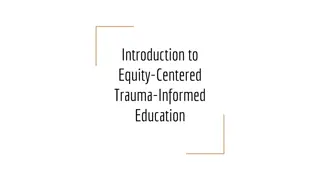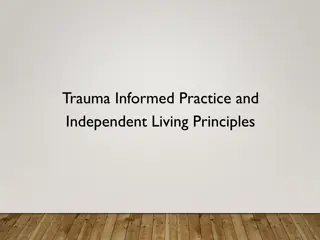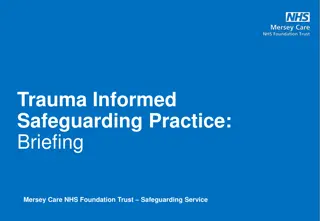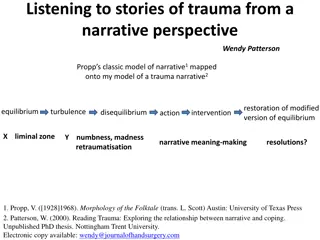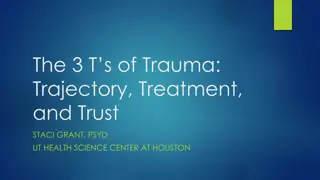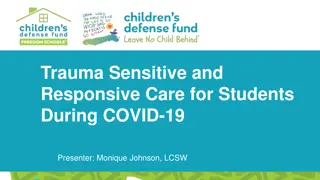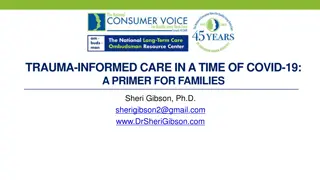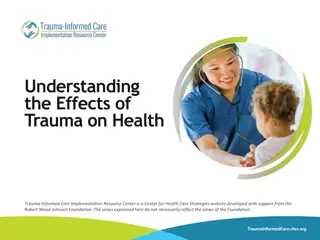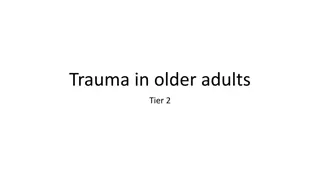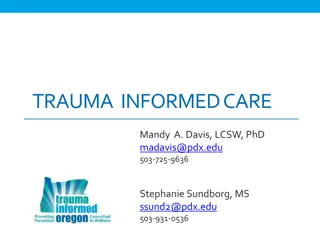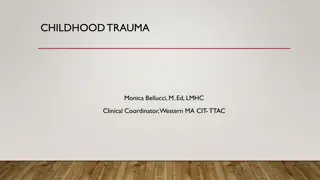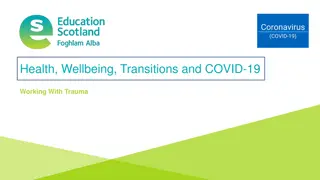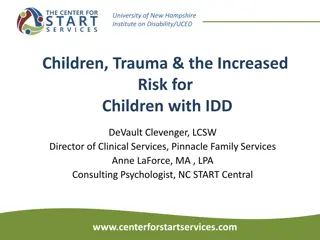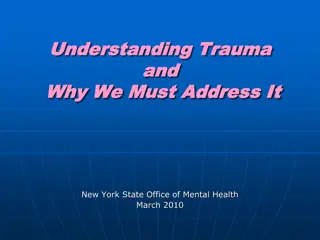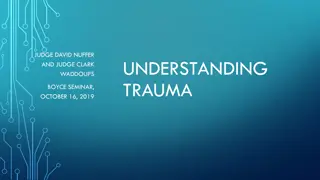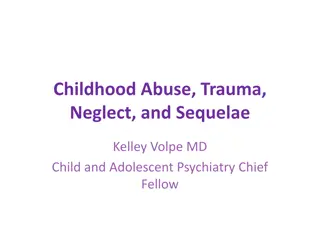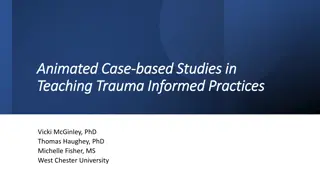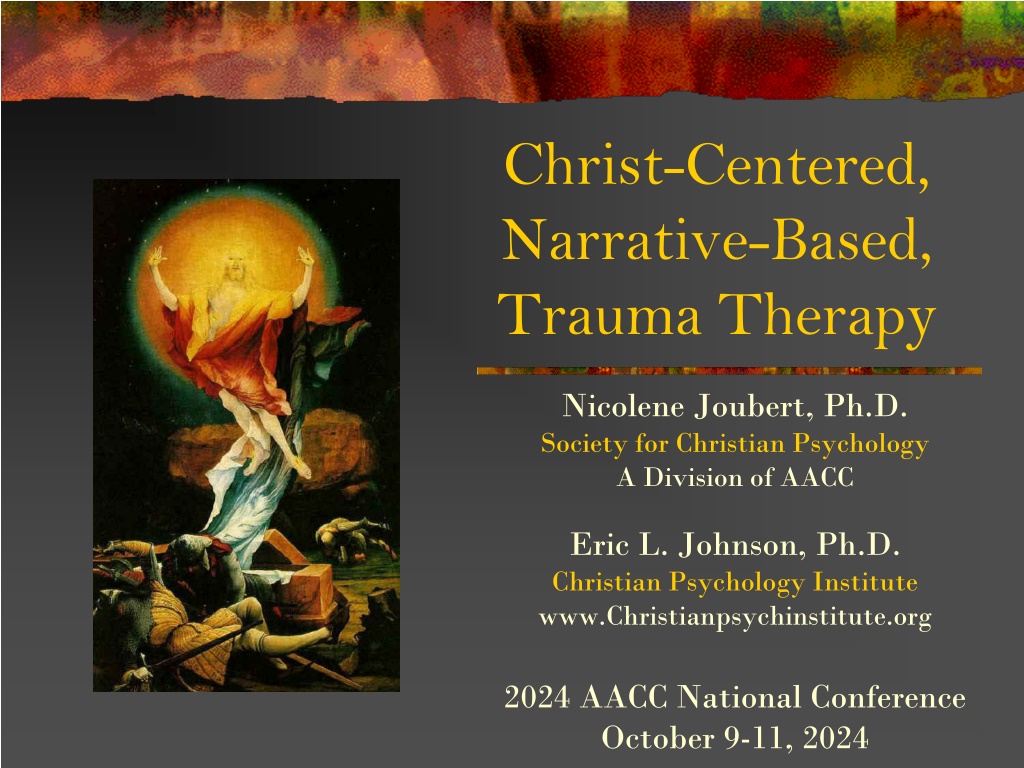
Christ-Centered Trauma Therapy and Worldview Integration
Explore the integration of Christ-centered narrative-based trauma therapy with worldview considerations in modern psychology. Learn how a Christian worldview offers therapeutic benefits and deeper insights into human flourishing. Discover the importance of incorporating Christian resources in therapy, regardless of the counselor or counselee's religious beliefs.
Uploaded on | 0 Views
Download Presentation

Please find below an Image/Link to download the presentation.
The content on the website is provided AS IS for your information and personal use only. It may not be sold, licensed, or shared on other websites without obtaining consent from the author. If you encounter any issues during the download, it is possible that the publisher has removed the file from their server.
You are allowed to download the files provided on this website for personal or commercial use, subject to the condition that they are used lawfully. All files are the property of their respective owners.
The content on the website is provided AS IS for your information and personal use only. It may not be sold, licensed, or shared on other websites without obtaining consent from the author.
E N D
Presentation Transcript
Christ-Centered, Narrative-Based, Trauma Therapy Nicolene Joubert, Ph.D. Society for Christian Psychology A Division of AACC Eric L. Johnson, Ph.D. Christian Psychology Institute www.Christianpsychinstitute.org 2024 AACC National Conference October 9-11, 2024
Therapy & Worldview The most important issue in contemporary therapy today is worldview (WV) A WV is the taken-for-granted set of beliefs, attitudes, feelings, values, loves, possibilities, dispositions, and goods common to a community that provides the context or horizon within which its members live (Naugle, 2002; Scheler, 1973; Taylor, 1989; 2007). A Christian WV dominated Western culture until the late 1800 s, when a secular revolution (Smith, 2003) occurred, and a secular WV became dominant in Western universities. Modern psychology was birthed in the secular revolution. Christians faced two problems: 1) natural science research methods were introduced to psychology that help us understand God s creation better (in some ways); 2) As WV minorities, Christians couldn t be too critical from a WV standpoint, or they wouldn t be allowed to participate in the field, even at present.
Therapy & Worldview Modern models of therapy are all based on a secular worldview (WV): 1. Psychopathology is due solely to biopsychosocial factors 2. There is no God, so improvement is due solely to human efforts 3. There are no transcendent ethical standards outside of the therapy process 4. Depending on the model, they are more or less individualistic Some popular modern models of therapy are also influenced by Buddhism (IFS, DBT, ACT, and Mindfulness-Based CBT)
Therapy & Worldview A Christian WV has many features that make it therapeutically better than a secular WV 1. Historic Christianity affirms the role of biopsychosocial factors and the value of human effort in human life. So, we can learn much from secular psychology. However, the Bible reveals some essential WV assumptions: 2. All good comes ultimately from God (Ja 1:17) 3. Being made in God s image (Gen 1:28-31), humans flourish best with ethical integrity and in a reciprocal love relationship with their Creator 4. Christian teaching about creation leads X ns to trust themselves (e.g., the law of God written on their heart; Ro 2:12-13) and about fallenness leads X ns to mistrust themselves (Jer 17:9), and rely on God and others for help 5. Humanity was created so the triune God could author a glorious story of soul-healing (Is 43:9) that stars the Son, with the Spirit playing a co- authoring role with those who follow him.
Therapy & Worldview All psychotherapy assumes a WV; but it s not noticed unless the counselor and counselee have markedly different WVs So, for the rest of our time together, we re going to be assuming a Christian WV. Being a Christian WV therapist doesn t require the counselee to be a Christian. But if both counselor and counselee are Christian, the therapy can utilize a lot more Christian resources. Like Jesus.
Were developing a new model of therapy It has the following features: 1. Christ-centered (i.e., he participates in some sessions) 2. Biblically based and enriched by Christian soulcare 3. Science-informed and enriched by secular therapy research 4. Yet, as a result of concerns about the role of worldview in modern therapy, it seeks to allow maximal Christian influence Christ-centered, narrative-based trauma therapy
Sarah Groves Less than Scars https://www.youtube.com/watch?v =_CjbCcyIiQw
Sarah Groves Less Like Scars It's been a hard year, but I'm climbing out of the rubble These lessons are hard, healing changes are subtle But every day it's Less like tearing, more like building Less like captive, more like willing Less like breakdown, more like surrender Less like haunting, more like remember
Sarah Groves Less Like Scars, contd And I feel you here, and you're picking up the pieces Forever faithful It seemed out of my hands, a bad situation But you are able And in your hands the pain and hurt Look less like scars and more like character
Sarah Groves Less Like Scars, contd Less like a prison, more like my room It's less like a casket, more like a womb Less like dying, more like transcending Less like fear, less like an ending
Sarah Groves Less Like Scars, contd And I feel you here, and you're picking up the pieces Forever faithful It seemed out of my hands, a bad situation But you are able And in your hands the pain and hurt Look less like scars and more like character
Sarah Groves Less Like Scars, contd Just a little while ago I couldn't feel the power or the hope, I couldn't cope, I couldn't feel a thing Just a little while back I was desperate, broken, laid out, hoping you would come And I need you And I want you here And I feel you
Sarah Groves Less Like Scars, contd And I feel you here, and you're picking up the pieces Forever faithful It seemed out of my hands, a bad situation But you are able And in your hands the pain and hurt Look less like scars and more like character
The Biblical, Soul- Healing Meta-Narrative Narrative therapy is deeply embedded in Christianity. Why do we say that? The Bible situates humanity with a story of divine healing that begins w/ creation & climaxes in eternity with God 1. The story is dominated by four major events Creation, the Fall, Redemption, and the Consummation, but Redemption (or Soul-Healing) is the main plot. 2. The ultimate author is the triune God Father, Son, and Holy Spirit. The story originated in the Father s imagination to glorify his Son, who is its hero. 3. Those created (good) in God s image are, nonetheless, born with a serious flaw (original sin) and are given an utterly unique origin story, composed of a mixture of suffering and joy, mostly in their family-of-origin, until they start authoring their own story in late adolescence/early adulthood.
The Biblical, Soul-Healing Meta-Narrative 4. The climax of Redemption is the heroic story of the Son, who became a human to bring healing to those who believe in him by joining himself to their sin (2Co 5:21), suffering (Mt 27:46), and woundedness (Is 53:6) (Stump, 2018). Believers in Christ are immediately united with Christ and his story, and given many gifts, incl. adoption into the triune God s family, their family-of- destiny, along with all God s children. The indwelling Holy Spirit is surely the best gift given, in part, to become increasingly a co-author with them of their personal story, to help them weave it experientially into Christ s story, so that, their story fulfills or supplants their family-of-origin story (usually both), so that it corresponds more and more to the Father s desired plotline and telos (Christlikeness),and at the same time manifests their utter uniqueness. In the course of their soul-healing journey, believers become heroes, too. (see Adler, 2012)
Narrative within the Christian Soul-Healing Tradition 1. Beginning in the Bible, the book of Acts sets the stage with a number of remarkable stories of the healing transformation of believers (e.g., Peter & Paul) 2. Many Christian biographies were written over the centuries to inspire Christians to pursue transformation, beginning with Athansius sThe Life of Anthony. 3. Augustine s (1991) Confessions is the classic Christian re-telling of one s story in light of the X n meta-narrative: I tell my story for love of your love! (p. 221) 4. Many stage models of psychospiritual development were composed in the early church and medieval eras 5. John Bunyan s (1678/2009) Pilgrim s Progress became an archetypal allegorical narrative for generations of Protestants. 6. C. S. Lewis and J. R. R. Tolkien (inspired by George MacDonald) argued that truth can be conveyed through narrative and symbolism, sometimes to greater effect than prose (see Ryken, 2002). 7. Evangelicalism, through revivalism, came to embrace a powerful, but extremely simplistic narrative (McAdams, 2021), summarized by the line from Amazing Grace, I once was lost, but now am found; was blind, but now I see, (which McAdams [2013] argues led to the redemptive self, a master narrative common in America)
Modern Psychology Documented the Impact of One s Family-of-Origin Story Perhaps modern psychology s greatest discovery: One s earliest experiences come to shape one s development across the lifespan 1. Freud s discovery of the formative impact of the family-of-origin story (though he got many details wrong), confirmed by psychodynamic case studies, orphanage studies, animal studies, and early attachment research 2. The 3rd-generation attachment research of Mary Mains (1995) and others, using the Adult Attachment Interview, demonstrated that the quality of one s family-of-origin experiences affects the ability to form a coherent narrative by adulthood When adults with securely attached children were asked to tell their own family-of-origin story, Mains (1995; Siegel, 2020) found the stories were more coherent, detailed, and objective, regardless of the degree of suffering reported; compared with adults with insecurely attached children whose stories were more fragmented, overidealized, emotionally unresolved, and verbally obscure, with greater memory lapses.
Modern Research on Narrative in Human Life 1. Over the past 4 decades, McAdams (2021) has forged a remarkable research program documenting the fundamental role of narrative in human life, encompassing personality, development, motivation, culture, identity, suffering, meaningfulness, and political views. 2. Adolescents use autobiographical reasoning to form narrative themes that shape their stories (Habermas & Bluck, 2000). 3. One s narrative identity is shaped through conversation as people share episodes with others, get feedback from them, which in turn informs how the episode is interpreted and stored (McLean, et al., 2007). 4. Cultures provide master narratives that shape the individual stories of their members (e.g., the holy man; the poor child who becomes rich; the scientist; the entrepreneur) (Hammack, 2008). 5. Narrative identity contributes to a sense of personal wellbeing (Adler, et al., 2016).
Different Ways Narrative Informs Modern Therapy Modern models vary in the degree to which they focus on narrative 1. Most modern models of therapy encourage some exploration of difficult episodes in one s story, including psychodynamic, family-systems, and experiential models, as well as EMDR 2. Cognitive-Behavioral Therapy seems to largely ignore narrative and generally stays in the present 3. Narrative therapy (obviously makes story its primary modality. It has been found to be effective in treating a variety of psychological problems, like depression (Lopes, et al., 2014; Vromans & Schweitzer, 2011) and social phobia (Looyeh, et al., 2014), as well as trauma.
Different Ways Narrative Informs Modern Therapy Some modern models use narrative in unique ways 1. Polyvagal theory (Dana, 2018; Porges, 2024) provides a way to reinterpret one s childhood story by discovering one s current pattern of nervous system activation, and offers remediation by promoting co-regulation of counselee emotions, in a context of relational safety, until they develop the skills to regulate them on their own 2. Internal Family Systems (IFS) therapy (Schwartz & Sweezy, 2019) offers an appealing easy-to-grasp framework with narrative implications that helps in recognizing one s parts (or subselves) (e.g., burdens) 3. Attachment therapy using the Ideal Parent Protocol (Brown & Elliott, 2016) coaches counselees to imagine how ideal parents would interact with them as children, in effect, creating healthy stories that provide reparative relational experiences in one s imagination.
Different Ways Narrative Informs Modern Therapy Counselees construct narratives about the therapy process itself 1. Successful emotion-focused therapy with depression involves specific changes in one s narrative about the therapy process (Mendes, et al., 2010) 2. In studies of counselees, Adler (2012; et al., 2008) found that those with the greatest wellbeing were more likely to have created heroic therapy narratives in which they overcome their psychological problems successfully, and they felt their agency was more responsible than the therapist s contributions. We recall the earlier narrative insight that useful therapy promotes re- experiencing the old, unsettled conflict but with a new ending (Alexander & French, 1946).
What is trauma? Suffering is physical or psychosocial pain that activates the SNS and its negative emotion systems; when extreme in severity and/or duration, suffering may activate the dorsal vagal system (which shuts off the pain and the negative emotions - dissociated). Trauma occurs when the suffering damages a person s created-good self and its capacities, leaving the SNS permanently overactivated or underactivated, affecting the future self and its story. Future personal sin is shaped by such damage.
Narrative Therapy for Trauma Research on three secular models of narrative therapy has found they resolve trauma and foster wellbeing 1. Narrative Exposure Therapy (NET) encourages talking about traumatic events in detail, while reexperiencing their associated embodied, emotional, and cognitive elements and exploring their originally perceived meaning, to desensitize counselees to those events and place them in a more comprehensive, meaningful narrative context from a present perspective (Lely, et al., 2019; Schauer, et al., 2011; Siehl, et al., 2021; Wei & Chen, 2021) 2. STAIR (Skills Training in Affective and Interpersonal Regulation) Narrative Therapy (Hassija & Cloitre, 2015) emphasizes skill development in emotion awareness and regulation, question relational style and scripts learned in childhood, as preparation for exploring in detail traumatic events in one s life.
Narrative Therapy for Trauma 3. Narrative-informed, Emotion-Focused Therapy (EFT) for trauma (Paivio & Angus, 2017) helps counselees identify, differentiate, experience, and express distressful, unresolved negative emotion schemes (feelings and beliefs) related to traumatic events. Counselors use empathic exploration and imaginal confrontation interventions to help counselees learn to recognize and disidentify with the sense of self that they internalized and form more mature emotional responses (e.g., anger over mistreatment and grief over loss) and a more coherent, agentic narrative (see also Khayyat-Abuaita, et al., 2019) All three models emphasize the need to cultivate a safe, trusting relationship in phase 1 as prerequisite for working with the traumatic memories.
A Christ-Centered, Narrative-Based Framework for Trauma Therapy The Relational Pyramid Triune God Counselee Counselor Past Others
A Christ-Centered, Narrative-Based Framework for Trauma Therapy The World, Flesh, Sin The New Creation Redemptive + Created Goodness Fallenness Created Goodness Fallenness (Sin, Suffering, & Created Damage) Meta-Narrative Context Old self New self Christ came to heal us and bring into the Trinity s love Humans are created good (Gen 1:31), but born in sin (Ro 3:23), and human suffering is massively, unevenly distributed
Long-Term Therapy Goal: Promoting a gradual change in the counselee s macro-narrative Family-of-Origin Story Family-of-Destiny Story Development of new beliefs, attitudes, emotions, relational style, and narrative identity (born again, forgiven sinner, child of God, beloved) Dominant emotions, attitudes, beliefs, relational style, unmet needs, trauma memories, and narrative identity (affirmed, trusted, golden boy, scapegoat, unlovable), mostly from family-of-origin Counselee s Macro-Narrative A new creation orientation, begun when baptized, grown through redemptive experiences mental change is easy; deep, heart change is much slower, much like learning a second language Created + Redemptive Good/Fallenness The default orientation out of which one lives one s life much like one s native language Created Goodness/Fallenness
Within-Session Goal: Promoting a Redemptive Micro-Narrative Fallen New-creation emotion state emotion state Negative emotion schemes are signs of exposure to fallenness earlier in story With support of therapist, HS, and sometimes Jesus, counselee modifies the fallen emotion state in direction of resolution/greater wellbeing, based on created and redemptive resources, signified by an emotion shift; when possible, finishing up the session in rest/peace/love (and PNS) When counselee feels safe enough, within- session goal is to access a fallen emotion state (SNS/dorsal vagal), perhaps related to childhood or recent episode, and experience, express, understand, and disidentify with it Counselee s Micro-Narrative Redemptive + Created Good/Fallenness Created Goodness/Fallenness Experiential union with Christ s resurrection Experiential union with Christ s death
An Outline of a Christ-Centered, Narrative-Based Model of Trauma Therapy 1. We are born into a fallen family and world created good by God, but characterized by (more or less) sin, suffering, and biopsychosocial damage (e.g., from trauma). The meaningfulness of our origin story (and its good-to- bad ratio) forms our self and its capacities and relationality (template), including trust in the validity of all that we experienced (including our parents treatment of us). If we are loved, we own that meaning and receive our loveableness; if we feel despised, we take that into our self. We are unable to resist it in childhood and are unaware of its distortions. We inherit our story and its template and it all becomes our default or primal base of operations 2. Because of Christ s story, his followers become united to him and his story, and become a part of the new creation. Their family-of-origin base becomes their old story, old self, and old template. And they begin a new story of Christian experiences, implanted with the seed of a new self and a new growing template of beliefs, emotions, and dispositions, and relational style.
An Outline of a Christ-Centered, Narrative-Based Model of Trauma Therapy 3. Working within the context of the divine meta-narrative, counselees experience repeated redemptive micro-narratives in session (and increasingly in homework and life), which increases their created/redemptive goodness and brings resolution to some of their fallenness, gradually changing the good-to-bad ratio of their macro-narrative The body is an essential part of therapy, because body and soul are mysteriously united. So, becoming aware of, listening to and managing one s body are essential skills on the healing journey. Emotions are experienced in the torso, and they are meaningful signs of truth: the past and the present, and (in some ways) the future. A goal of Christ-centered therapy is nervous system management, resulting in decreasing of unwarranted SNS and dorsal vagal activation and increasing PNS activation That s a big reason why Christian meditation is so important for the therapy journey 4.
An Outline of a Christ-Centered, Narrative-Based Model of Trauma Therapy 5. Relationships with safe others (including God, if we experience him as safe) facilitates the activation of the PSN (what Porges calls the social engagement system ). Overtime people can do this in their devotions This model is called Christ-centered because it prioritizes the use of prayerful therapy strategies that bring Christ into the session or personal devotions as tangibly as possible. through Scripture reading (lectio divina),guided (or unguided) imagery, and chair techniques. 6. We will be introducing you to a variety of Christ-centered techniques during the rest of our time together.
Sponsoring Organizations www.Christianpsychinstitute.org Visit our new website and become a member Join this division of AACC www.aacc.net, look under Memberships
References Adler, J. M. (2012). Living into the story: Agency and coherence in a longitudinal study of narrative identity development and mental health over the course of psychotherapy. Journal of Personality and Social Psychology, 102, 367-389. Adler, J. M., Lodi-Smith, J., Philippe, F. L., & Houle, I. (2016). The incremental validity of narrative identity in predicting well-being. A review of the field and recommendations for the future. Personality and Social Psychology Review, 20, 142-175. Adler, J. M., Skalina, L., & McAdams, D. P. (2008). The narrative reconstruction of psychotherapy and psychological health. Psychotherapy Research, 18, 719-734. Alexander, F., & French, D. (1946). Psychoanalytic Therapy: Principles and Application. Ronald Press, Augustine. (1991). Confessions (H. Chadwick, Trans.). Oxford World s Classics. Balthasar, H. U. von. (1988-1998). Theo-drama: Theological dramatic theory (Vols 1-5). Ignatius. Bartholomew, C., & Goheen, M. (2004). The drama of Scripture: Finding your place in the biblical story. Baker. Brown, D. P., & Elliott, D. B. (2016). Attachment disturbances in adults: Treatment for comprehensive repair. W. W. Norton. Bunyan, J. (2009). Pilgrim s Progress. Penguin Classics. (Original work published 1678) Carson, D. A. (2010). The God who is there: Finding your place in God s story. Baker. Cloitre, M., Cohen, L. R., Ortiga, K. M., Jackson, C., & Koenen, K. C. (2020). Treating survivors of childhood abuse and interpersonal trauma: STAIR narrative therapy. Guilford.
References, contd Dana, D. (2018). Polyvagal theory in therapy. Guilford. Elbert, T., Schauer, M., & Neuner, F. (2022). Narrative exposure therapy (NET): Reorganizing memories of traumatic stress, fear, and violence. In Evidence based treatments for trauma-related psychological disorders: A practical guide for clinicians (pp. 255-280). Cham: Springer International Publishing. Habermas, T., & Bluck, S. (2000). Getting a life: The emergence of the life story in adolescence. Psychological Bulletin, 126, 748-769. Hammack, P. L. (2008). Narrative and the cultural psychology of identity. Personality and Social Psychology Review, 12, 222-247. Hassija, C. M., & Cloitre, M. (2015). STAIR narrative therapy: A skills focused approach to trauma-related distress. Current Psychiatry Reviews, 11(3), 172-179. Khayyat-Abuaita, U., Paivio, S., Pascual-Leone, A., & Harrington, S. (2019). Emotional Processing of Trauma Narratives Is a Predictor of Outcome in Emotion-Focused Therapy for Complex Trauma. Psychotherapy, 56(4), 526-536. http://dx.doi.org/10.1037/pst0000238 Lely, J. C. G., Smid, G. E., Jongedijk, R. A., W. Knipscheer, J., & Kleber, R. J. (2019). The effectiveness of narrative exposure therapy: a review, meta-analysis and meta-regression analysis. European Journal of Psychotraumatology, 10(1). https://doi.org/10.1080/20008198.2018.1550344 Looyeh, M. Y., Kamali, K., Ghasemi, A., & Tonawanik, P. (2014). Treating social phobia in children through group narrative therapy. The Arts in Psychotherapy, 41(1), 16-20. DOI: 10.1016/j.aip.2013.11.005
References, contd Lopes, R. T., Gon alves, M. M., Machado, P. P. P., Sinai, D., Bento, T., & Salgado, J. (2014). Narrative Therapy vs. Cognitive-Behavioral Therapy for moderate depression: Empirical evidence from a controlled clinical trial. Psychotherapy Research, 24(6), 662-674: 10.1080/10503307.2013.874052 Mains, M. (1995). Attachment: Overview, with implications for clinical work. In S. Goldberg, R. Muir, & J. Kerr (Eds.), Attachment theory: Social, developmental, and clinical perspectives (pp. 407-474). Analytic Press. McAdams, D. P. (2013) The redemptive self: Stories Americans live by. Oxford University Press. McAdams, D. P. (2021). Narrative identity and the life story. In O. P. John & R. W. Robins (Eds.), Handbook of personality (4th ed., 122-144). Guilford. McLean, J. C., Pasupathi, M., & Pals, J. L. (2007). Selves creating stories creating selves: A process model of self- development. Personality and Social Psychology Review, 11, 262-278. Mendes, I., Ribeiro, A. P., Angus, L., Greenberg, L. S., Sousa, I., & Gon alves, M. M. (2010). Narrative change in emotion-focused therapy: How is change constructed through the lens of the innovative moments coding system? Psychotherapy Research, 20(6), 692-701. Naugle, D. (2002). The worldview: The history of a concept. Eerdmans. Paivio, S. C., & Angus, L. E. (2017). Narrative processes in emotion-focused therapy for trauma. Guilford. Porges, S. (2024). Polyvagal perspectives: Interventions, practices, & strategies. W. W. Norton.
References, contd Scheler, M. (1973). Selected philosophical essays. Northwestern University Press. Schwartz, R., & Sweezy, M. (2019). Internal family systems therapy (2nd ed.). Guilford. Siegel, D. (2020). The developing mind (3rd ed.). Guilford. Siehl, S., Robjant, K., & Crombach, A. (2021). Systematic review and meta-analyses of the long-term efficacy of narrative exposure therapy for adults, children and perpetrators. Psychotherapy Research, 31(6), 695-710. Smith, C. (2003). The secular revolution: Power, interests, and conflict in the secularization of American public life. University of California Press. Stump, E. (2018). Atonement. Oxford University Press. Taylor, C. (1989). Sources of the self: The making of the modern identity. Harvard University Press. Taylor, C. (2007). Modern social imaginaries. Duke University Press. Vanhoozer, K. (2005). The drama of doctrine. Westminster John Knox. Vanhoozer, K. (2014). Faith speaking understanding: Performing the drama of doctrine. Westminster John Knox. Vromans, L. P., & Schweitzer, R. D. (2011) Narrative therapy for adults with major depressive disorder: Improved symptom and interpersonal outcomes, Psychotherapy Research, 21(1), 4-15. DOI: 10.1080/10503301003591792 Wei, Y., & Chen, S. (2021). Narrative exposure therapy for posttraumatic stress disorder: A meta-analysis of randomized controlled trials. Psychological Trauma: Theory, Research, Practice, and Policy, 13(8), 877 884. doi.org/10.1037/tra0000922
Appendix 1 Summaries of the Christian Meta-Narrative (From shortest to longest) Johnson, E. L. (2017). God and soul care: The therapeutic resources of the Christian faith. Chapter 5: Stories of Glory. InterVarsity. Bartholomew, C., & Goheen, M. (2004). The drama of Scripture: Finding your place in the biblical story. Baker. Carson, D. A. (2010). The God who is there: Finding your place in God s story. Baker. Vanhoozer, K. (2005). The drama of doctrine. Westminster John Knox. Vanhoozer, K. (2014). Faith speaking understanding: Performing the drama of doctrine. Westminster John Knox. Balthasar, H. U. von. (1988-1998). Theo-drama: Theological dramatic theory (Vols 1- 5). Ignatius.
Appendix 2 From time immemorial, humans have loved a good story, and they can promote our healing Consider 1. Chronicles of Narnia 2. Lord of the Rings 3. Flannery O Connor 4. Zombie movies 5. Ordinary People 6. Inside Out



